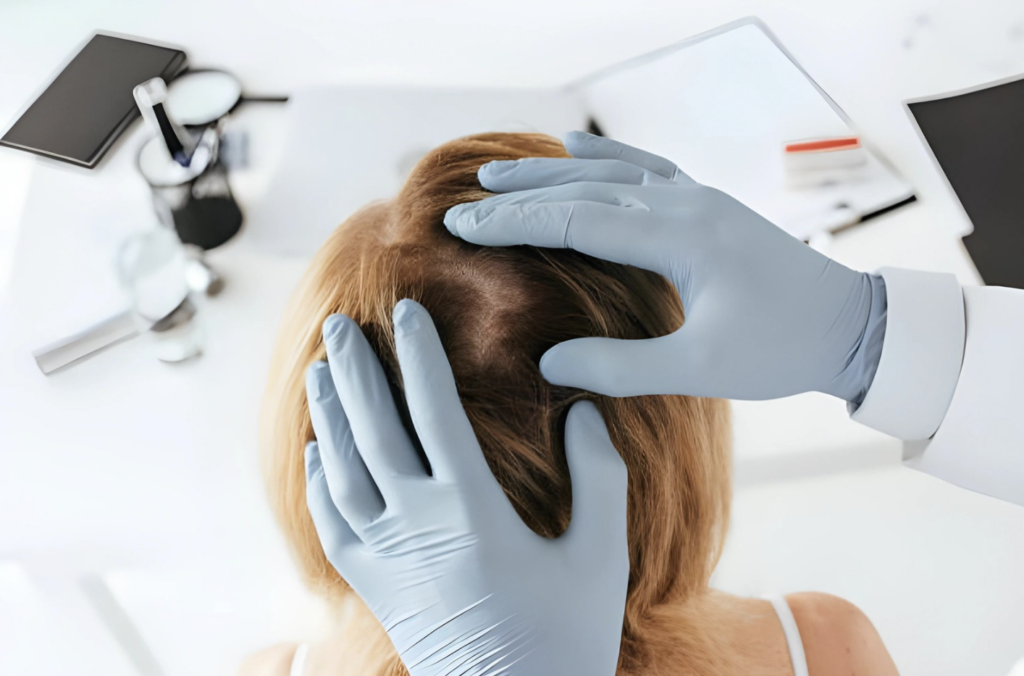Health Conditions
Detecting Skin Cancer on the Scalp
While many of us dutifully apply sunscreen to our exposed skin before venturing outside, one region is frequently overlooked: the scalp. Despite its hidden appearance, skin cancer on the scalp is a serious problem, and early discovery is critical for effective treatment.
In this article, we’ll look at how important it is to be alert in the identification of skin cancer on the scalp. We’ll look at everything from risk factors to signs and symptoms to figure out how to diagnose this often-overlooked type of skin cancer.
In addition, we’ll go over numerous ways and strategies for conducting self-examinations and seeking professional medical evaluation to ensure early diagnosis and treatment. Whether you have a full head of hair or are thinning or balding, knowing how to spot skin cancer on the scalp is critical for preserving good skin health.
By throwing light on this lesser-known component of skin cancer diagnosis, we hope to provide readers with the information and tools they need to protect themselves and their loved ones from this unseen menace hiding beneath the surface.

Identifying Skin Cancer on the Scalp
Skin carcinoma of the scalp is a form of cancer that begins in the cells of the scalp. It is critical to be able to recognize the signs and symptoms in order to receive timely diagnosis and treatment. This section of the article will go over the common signs and symptoms, the many forms of skin cancer that affect the scalp, and the ABCDEs of melanoma.
Common Signs and Symptoms
The signs and symptoms differ depending on the type of malignancy. Some common signs and symptoms are:
- A patch or mole on the scalp that varies its color, shape, or size.
- An itchy or bleeding sore on the scalp that will not heal
- A scaly patch on the scalp that could be red or irritated
- A wart-like growth on your scalp
If you see any of these signs or symptoms on your scalp, you should consult a doctor for additional assessment.

Types of Skin Cancer Affecting the Scalp
A variety of skin cancers can affect the scalp, including:
Basal cell carcinoma is the most prevalent skin cancer on the scalp. It frequently appears as a flesh-colored or pink lump with a glossy or waxy appearance.
Squamous cell carcinoma is the type of skin cancer that might present as a scaly patch or a wart-like growth on the scalp.
Melanoma is a less common but more dangerous kind of skin cancer that can manifest as a mole on the scalp. It might be black, brown, pink, red, or white.
The ABCDE’s of Melanoma
Melanoma is a kind of skin cancer that is fatal if not diagnosed early. The ABCDEs of melanoma might help you recognize probable symptoms of this type of skin cancer on your scalp:
- A: Asymmetry – This occurs when one half of the mole or spot differs from the other.
- B: Border – The boundaries of the mole or spot are uneven or indistinct.
- C: Color – the mole or spot has various colors or tones.
- D: Diameter – The mole or spot measures more than 6mm in diameter.
- E: Evolving – The mole or spot is changing size, shape, or color.
If you observe any of these symptoms on a mole or lesion on your scalp, you should consult a doctor for additional evaluation.
Finally, recognizing skin cancer on the scalp is critical for early detection and treatment. Knowing the frequent signs and symptoms, kinds of skin cancer that affect the scalp, and the ABCDEs.
Risk Factors and Prevention
Understanding Risk Factors
Certain variables can make a person more likely to acquire scalp skin cancer. One of the most important risk factors is sun exposure. People who spend a lot of time in the sun, particularly without sunscreen, are more prone to acquiring scalp skin cancer. This occurs because the scalp is frequently exposed to sunlight, and the skin on the scalp is thinner than the skin on the rest of the body.
People with pale complexion are also more likely to get skin cancer on their scalp. This is because fair skin contains less melanin, which gives some protection from the sun’s UV rays. Furthermore, those with a family history of skin cancer are more prone to getting it on their scalp.
Preventative Measures
Fortunately, people can take many precautionary measures to lower their risk of acquiring scalp skin cancer. One of the most crucial things is to shield the scalp from the sun’s damaging UV radiation. This can be accomplished by wearing a hat or other protective headwear while spending time outside. Furthermore, people should avoid spending time outside during peak sun hours, which are usually between 10 a.m. and 4 p.m.
Sunscreen is also an important preventive step. People should use sunscreen with an SPF of at least 30 and apply it to their scalps and other exposed regions of skin 30 minutes before going outside. Reapply sunscreen every two hours, after swimming or exercise.
Avoiding tanning beds is another key preventive measure. Tanning beds expose the skin to dangerous UV rays, raising the risk of getting skin cancer on the scalp and other areas of the body.
Finally, folks should keep a close eye on their scalp for any unexpected growths or changes in moles. This should be done on a monthly basis, with any changes reported to a healthcare physician as soon as feasible. People who take these precautions can lower their risk of acquiring skin cancer on their scalps and other parts of their bodies.

Diagnosis and Treatment
Professional Diagnosis
If someone feels they have skin cancer on their scalp, they should visit a doctor or dermatologist right away. A dermatologist is a doctor who specializes in skin problems and can detect skin cancer. A dermatologist may use a dermatoscope, a special magnifying lens, to inspect the scalp more carefully. If the dermatologist feels the growth is malignant, they may do a biopsy, which involves extracting a small sample of the tumor to examine under a microscope.
Available Treatment Options
Treatment is determined by the cancer’s kind, size, and location. Surgery, radiation therapy, chemotherapy, immunotherapy, Mohs surgery, and photodynamic therapy are some of the potential treatment options.
Skin cancer on the scalp is most commonly treated with surgery. The malignant tumor will be removed, along with a border of good skin. If the malignancy is significant, the surgeon may need to remove a portion of the scalp and reconstruct it with a skin transplant.
- Radiation therapy uses high-energy X-rays to kill cancer cells. It is commonly used in conjunction with surgery to treat scalp skin cancer.
- Chemotherapy employs chemicals to eliminate cancer cells. It is often reserved for advanced skin cancer that has progressed to other areas of the body.
- Immunotherapy works by increasing the immune system to combat cancer cells. It is a relatively recent therapy method that has demonstrated potential in the treatment of advanced skin cancer.
- Mohs surgery is a specialist surgical method that includes eliminating malignant growths layer by layer until all cancer cells are eliminated. It is commonly used to treat skin cancer on the face and scalp.
- Photodynamic therapy consists of administering a unique medicine to the skin and then exposing it to a specific type of light. The medicine makes cancer cells more sensitive to light, which destroys them.
Finally, the treatment for this form of cancer is determined by its type, size, and location. If you feel you have it, see a doctor or dermatologist right once for a professional diagnosis and treatment options.

Aftercare and Monitoring
Post-Treatment Care
Following treatment for scalp skin cancer, it is critical to appropriately care for the affected area. The doctor will give you precise advice on how to care for the wound, such as keeping it clean and dry, avoiding sun exposure, and taking the medication as directed.
It is also critical to schedule regular check-ups with your doctor to monitor the healing process and ensure that the cancer does not return. If you notice any signs of infection, such as redness, swelling, or discharge, contact your doctor right away.
Ongoing Monitoring and Check-Ups
Following treatment for skin cancer on the scalp, continued monitoring and check-ups are required to ensure that the cancer does not recur. The doctor may urge that you have regular skin exams to look for new growths or changes in existing moles.
In addition, the doctor may examine the lymph nodes to ensure that the malignancy has not spread. Early detection is essential for successful treatment, so report any new symptoms or changes in the scalp area to your doctor as soon as possible.
Dermatologists are skin problem specialists who may offer expert advise on how to avoid skin cancer and check for any changes. They can also perform regular skin checks to detect early signs of skin cancer.
Finally, adequate aftercare and continuing monitoring are essential following treatment for scalp skin cancer. Individuals who follow the doctor’s directions and attend regular check-ups can ensure that they are taking the essential steps to prevent the cancer from returning and maintaining a good perspective for the future.
Trusted Health, Wellness, and Medical advice for your well-being



